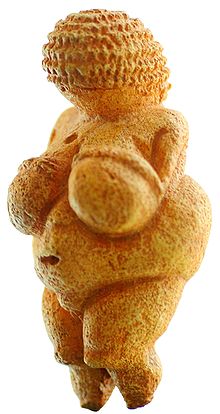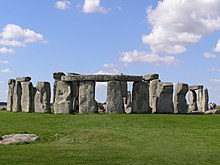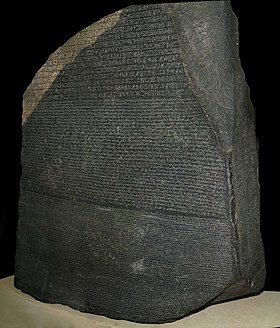3 Chapter 3: Ancient Arts (Prehistoric, Ancient Near East, Egyptian)
Prehistoric Art
Prehistoric art is art created before the dawn of recorded history. Mostly known for cave paintings but also includes sculptures and architecture. A time period that covers millions of years until the beginning of written history that started ca. 3500 BCE in the ancient Near East. The caves we came out of are littered with the tools we used to create art.
Paleolithic-Old stone age (Paleo = old; Lith = stone)
Mesolithic-middle stone age (meso = middle)
Neolithic-New stone age (Neo = new) Characterized by a change in relationship between humans and their environments, domestication of animals and plants, more substantial structures built.

Venus of Willendorf
From Willendorf, Austria, ca. 25,000–21,000 BCE. Limestone; 4 3/8 in. high.
- Many of these Venus figurines date from ca. 30,000–11,000 BCE and are found from Europe to Siberia and made from soft material like clay, bone, calcite, and Ivory.
- Carved from limestone that was not from the local area and tinted with red ochre.
- A Sculpture in the Round is a 360-degree view, meaning you can see the bottom, top, sides, etc.
- The deep navel is a natural indention in the stone. It never had feet.
- May stress health/fertility/beauty. Emphases on the belly, breast, and pubic area.

Hall of the Running Bulls, Lascaux, France, ca. 15,000–13,000 BCE. Paint on limestone rock. The Lascaux cave was rediscovered in 1940 by teenagers when their dog fell in a hole. Of the images depicted in the caves, 72% were not hunted for food.
Ask yourself: Why did prehistoric humans spend time and energy away from surviving to create art? What functions did these visuals represent or serve? What do the images mean?
A good documentary to watch is the Cave of Forgotten Dreams on the discoveries of the Chauvet cave. Trailer: https://youtu.be/qfJfRx2IAYo


Stonehenge, Salisbury Plain, England, ca. 2800–1500 BCE. Stonehenge uses the first principle of architecture, Post and Lintel = 2 upright stones supporting a third horizontal lintel stone.
Ancient Near East
Ancient Mesopotamia is located in today’s Iraq and parts of Syria. It is here that we find some of the earliest evidence for what we can call civilization: political organization, religious beliefs, cities, and food storage.
Mesopotamia = the land between 2 rivers. The rivers are the Tigris River and Euphrates River. Bible stories from the Old Testament are from this time period, for example: Noah, Abraham, Garden of Eden.
- The Dawn of Civilization—Irrigation techniques led to fertile soil.
- Invention of the wheel & plow, batteries (Baghdad batteries), government, organized religion.
- Casting tools in metal.
- Writing system starts about 3500 BCE. Cuneiform = wedge-shape writing. Remember, history is written by the victors.
- Settlements allowed people a chance to excel or become proficient in 1 area.
Jericho Skull or Neolithic Skull, ca. 9000 BCE. The bodies were buried under a living room floor. The skulls were plastered and decorated to possibly be portraits of deceased family members or a form of ancestor worship. Jericho is one of the oldest continuously inhabited cities in the world dating back to 9000 BCE and is still inhabited today.

Jericho Skull, ca. 9000 BCE


Ishtar Gate, constructed ca. 575 BCE by order of King Nebuchadnezzar II.
- Eighth gate to the inner city of Babylon.
- Nebuchadnezzar II is believed to be the king who built the Tower of Babel and the Hanging Gardens of Babylon (a wonder of the ancient world).
- Made of glazed brick to give it a jewel-like appearance.
- Named after the goddess Ishtar.
- This is only a small 50’ piece of a part of the original gate; 45’ was attached below the gate, and it was said to be so deep that 2 chariots could patrol side by side on top of the gate.


Law Code of Hammurabi, ca. 1755–1750 BCE
- Hammurabi (1792–1750 BCE), 6th Babylonian king. His name means “the favorite shepherd.”
- The best preserved and longest law document from the ancient Near East.
- Believed it was his mission to bring justice to his people.
- The Sun god, Shamash, hands the ruling rod and ring to Hammurabi to show he was chosen by the gods to rule.
- Stele = an upright marker. Stele were used as monuments, usually made from stone or wood, and could be carved or painted with images and writing.
- 282 laws on punishment depending on social status.
- 1/2 of code is business law, and 1/3 of code deals with family and household law, with provisions for officials, military, and taverns.

Victory Stele of Naram-Sin, ca. 2254–2218 BCE, 6’7”. Made of pink sandstone, Akkadian Empire. The Akkadian king Naram-Sin was the first known king to wear the horned crown, declaring he is a god and has the divine right to rule. Hierarchical proportion = the biggest person is the most important. Size = status. Written in cuneiform.
Egyptian Art
Egyptian Art is about permanence, the afterlife, traditional, and unchanging. Plato once said Egyptian art hasn’t changed in 10,000 years. To everyone in the ancient world, Egypt was even more ancient—for example, Cleopatra is closer to us in age than the ancient Egyptians. Known as the bread basket, early settlements were here in 9000 BCE, and people were growing crops in the Nile valley (the bread basket) in the Neolithic time period. Upper and lower Egypt were unified in ca. 3100 BCE by the pharaoh Menses (also known as Narmer) as seen in the Palette of Narmer.

The Palette of Narmer, ca. 3200–3000 BCE, 25” high. Shows the pharaoh with the white crown of Upper Egypt, and on the other side he wears the red crown of Lower Egypt.
Pharaoh = god-King
Hieroglyphs—writing system the Egyptians developed at about the same time as the Mesopotamians were inventing cuneiform (3000 BCE).
Climatic and geographic conditions for Egyptian civilization were comparable to those of Mesopotamia. Egypt was a thriving culture, known as the bread basket, with access to the river valley of the Nile and annual inundations of the flooding river to fertilize the soil.
Egyptian history is divided into dynasties (or succession tables of pharaohs, established by the historian and priest Manetho, writing 2nd century BCE, when Egypt was under Roman dominance), which in turn are subsumed under the umbrella of the following larger historical epochs: Pre- and Early Dynastic Periods (ca. 5500 to 2700 BCE), Old Kingdom (ca. 2686 to 2155 BCE), Middle Kingdom (ca. 1975 to 1640 BCE), New Kingdom (ca. 1570 to 1070 BCE), Late Period (ca. 664 to 332 BCE), Ptolemaic Period (ca. 323 to 30 BCE) or Greek domination of Egypt; thereafter, Egypt was part of the Roman Empire.

Sakkara, Stepped Pyramid of King Zoser, Saqquara/Sakkara (necropolis of Memphis), ca. 2610 BCE, built by Imhotep. The first monumental royal tomb in ancient Egypt was built for King Zoser of the Third Dynasty. This tomb is often regarded as a precursor of the pyramids of Giza. The tomb of Zoser is a stepped pyramid, reminiscent of the Ziggurat temples of Mesopotamia, with an adjacent temple complex. This tomb was designed to protect the mummified body of the king, buried in a hidden, underground chamber.
Its creator, Imhotep was the first known artist/architect of recorded history. He was also a treasurer, vizier, high priest, doctor, and magician. He was so popular the Romans made him their god also.

Pyramids of Giza ca. 2551–2472 BCE, 1st Wonder of the World and the only one still standing. There is a causeway to each pyramid. New discoveries have been made recently: hidden rooms, solar alignments, and more.
The pyramid of Khufu, ca. 2530 BCE (the one in back on right) is known as the 1st and biggest at 480 feet high.
Khufu’s son, Khafre, 2500 BCE, built the middle pyramid, 22 feet shorter than Khufu’s. The Great Sphinx is in front of this one.
Menkaure’s pyramid ca., 2460 BCE, Khafre’s son.

Seated Scribe from Saqqara ca. 2551–2528. Made of painted Limestone. Retains his original paint. Scribes were the most educated in this society. They had to study law, mathematics, religion, writing, and reading. Less monumental in the cross-legged pose used for the scribes. Lower-ranked people were depicted more naturally with individual characteristics, like rolls of fat, potbellies, or sagging breasts.


Bust of Nefertiti, ca. 1349–1336 BCE. Painted limestone, 19″ high. She was the only queen to wear the blue crown. Known as the most balanced piece of sculpture. Her husband was the pharaoh Akhenaten. This piece was found in a trash pile, the left eye unfinished.
Rosetta stone—in 1799, Napoleon’s soldiers found it in the village of Rosetta.
Material is Granodiorite. Size: 44.2 in. × 29.8 in. × 11.2 in.
Writing is in ancient Egyptian hieroglyphs, Demotic script, and Greek script. Present location is the British Museum.


